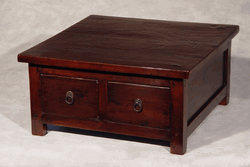A stylishly appointed dining room remains a hallmark of the American home, and can be decorated for both utility and beauty. A size and shape can be found to fit any dining space and to create any dining experience.
Typically, modern home design places the dining room immediately adjacent to the kitchen, for ease of access for food service and cleanup. But that wasn’t always so. In medieval times it was often on an entirely different floor level of the residence.
Stability and Strength
Over the years, the dinner table was used to signify stability and strength. During World War II, for example, one of the iconic images to come from that conflict is Norman Rockwell’s painting, “Freedom from Want,” which depicts a happy, smiling family gathered around the dining room table as the patriarch presides as a huge Thanksgiving Turkey is served to a smiling family. The painting adorned the cover of The Saturday Evening Post in 1943.
Television shows of the 1950s and 1960s also often focused on the dining room table for key scenes, shows like “Father Knows Best,” “Leave It to Beaver,” and “Happy Days” were built around the dining room and its importance to the family unit.
And while the 70s, 80s and 90s saw the trend move away from daily formal dining, family mealtime is still relevant in our culture. Studies have shown that children eat at least 4 to 6 meals with their family, and that those mealtimes go a long way toward facilitating their social, cognitive, emotional, and nutritional development.
They may not be eating home-cooked meals; instead the nightly menu may be fast food or from the freezer, and they may be eating it in front of the television or some other electronic distraction. But the dining room table still is the center of the family universe in American society.
Formal Dining Arrangements
Traditionally, a rather large dining table – called a trestle table – and a number of dining chairs dominates the typical dining room. Most commonly, tables are rectangular to accommodate larger numbers of dinner guest. In most American Homes, the dining table accommodates six diners without an extension and up to 10 with leaves to extend the table’s length.
Chairs from such an arrangement would come in even numbers, with two armed end chairs and an even number of unarmed side chars to round of the seating complement. The dining room also might contain other furniture pieces to match or complement the table. These pieces might include a side table or buffet, for serving, and a buffet or hutch for holding formal pieces of china and silver settings.
Modern Dining
As 21st Century living has changed to reflect the faster, more disposable times, fewer meals these days are actually taken in the dining room. Increasingly, the dining room has been relegated to use only for formal occasions, such as holiday meals or for celebrating a special occasion, such as a birthday or anniversary. More day-to-day dining is typically reserved for the kitchen, breakfast nook, or even the family room.
In England, the dining room is for many families only to be used on Sundays, with all other meals during the week taken in the kitchen. In Australia, family meals are often eaten at a breakfast counter or in front of the television in the lounge.
This is keeping with a modern trend toward a more comfortable dining experience. The wooden table and chairs in some sort of kitchen area is being replaced by couches and comfortable chair.
Visit the experts at Terra Nova Designs to find the perfect dining table to fit your lifestyle and living space.












